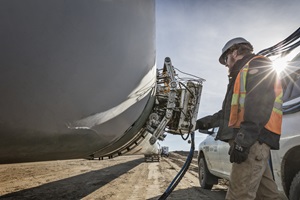Experience Quality: Premier Pipeline Welding Inspection Services You Can Trust Fund
Experience Quality: Premier Pipeline Welding Inspection Services You Can Trust Fund
Blog Article
Optimizing Effectiveness: Pipe Welding Inspection Ideal Practices
By applying best practices for pipe welding inspection, companies can improve procedures, lessen errors, and boost project timelines. The thorough attention to information called for in welding evaluation holds the essential to the long-term resilience and integrity of the pipelines, making it a subject of utmost value in the industry.
Significance of Efficient Welding Assessments
Effective welding examinations play an essential function in making sure the structural honesty and security of pipes. Proper evaluations are necessary to determine any kind of problems, suspensions, or imperfections in the welded joints that could compromise the total honesty of the pipeline system. By carrying out comprehensive evaluations, examiners can discover problems at an early stage, stopping potential leaks, ruptures, or failings that could have major ecological and safety and security effects.
Prompt and accurate welding inspections also assist in maintaining conformity with industry criteria and regulations. Sticking to these standards is not just a legal requirement but additionally a necessary action to guarantee the dependability and longevity of the pipelines. Additionally, reliable examinations can add to cost financial savings by minimizing the need for costly repairs or replacements due to welding problems that can have been avoided or fixed throughout the examination procedure.
Making Use Of Technology for Examinations
To boost the effectiveness and precision of pipe welding evaluations, the integration of advanced technologies has ended up being significantly necessary in making certain accurate and detailed evaluations of bonded joints. One of the vital technical innovations in pipe welding examinations is the use of automated ultrasonic screening (AUT) systems. By embracing these technological services, pipeline welding assessments can be performed more effectively, leading to greater high quality welds, enhanced overall safety, and decreased job timelines.
Developing Clear Evaluation Methods
Developing clear examination methods is important for ensuring uniformity and integrity in the pipe welding examination process. These protocols act as a collection of standards that lay out the particular steps, criteria, and techniques to be complied with during assessments. By clearly specifying the examination protocols, all inspectors entailed in the procedure can recognize their duties and responsibilities, bring about an extra reliable and standardized assessment workflow.

Routine testimonial and updates to the examination methods are likewise vital to adjust to altering sector criteria and needs. By continually refining and boosting the procedures based on responses and lessons discovered, pipeline welding evaluations can maintain the greatest quality criteria and regulative compliance.
Training and Certifications for Examiners

Educating and qualifications for inspectors are extremely important in making certain the skills and effectiveness of individuals charged with supervising pipeline welding processes - Pipeline Welding Inspection. Correctly educated assessors possess the necessary understanding and skills to properly review weld high quality, adherence to welding treatments, and compliance with market standards and guidelines
Accreditations, such as those offered by the American Welding Culture (AWS) or the American Oil Institute (API), confirm an examiner's experience and capacity to carry out assessments to the highest possible standards. These qualifications frequently require strenuous training, assessments, and continuous professional growth to make certain that inspectors stay present with the most up to date advancements in welding technology and assessment methods.
Along with formal certifications, constant training programs play an essential role in enhancing inspectors' abilities. These programs cover a wide variety of topics, including welding procedures, defect discovery, security methods, and relevant codes and requirements (Pipeline Welding Inspection). By spending in thorough training and accreditations for assessors, firms can maintain the Discover More stability of their pipeline welding projects and reduce the dangers connected with low quality welds
Continual Improvement in Evaluation Processes
Structure upon the foundation of skilled and qualified assessors, continual enhancement in inspection processes is necessary for making sure the continuous high quality and compliance of pipe welding procedures. By applying a system of continual renovation, pipe welding assessment procedures can advance to meet the transforming needs of the market, technological improvements, and regulatory requirements. This includes consistently examining and evaluating inspection methods, devices, and procedures to determine locations for improvement.
One trick element of continual renovation in assessment processes is feedback. Collecting input from assessors, welders, designers, and various other stakeholders permits a comprehensive assessment of existing methods and the identification of possible locations for renovation. Furthermore, leveraging analytics and data can offer useful insights right into the efficiency of examination processes, making it possible for educated decision-making for optimization.
Moreover, purchasing training and development programs for inspectors can ensure that they are geared up with the most current expertise and abilities to execute their obligations efficiently. Continual enhancement is a dynamic procedure that calls visit site for devotion and commitment from all stakeholders to drive excellence in pipeline welding examination techniques.
Final Thought
To conclude, maximizing effectiveness in pipe welding evaluations is vital for making sure the high quality and security of framework tasks. By using technology, developing clear protocols, giving appropriate training and certifications for examiners, and constantly enhancing evaluation processes, companies can enhance their procedures and decrease threats. It is essential for sectors to prioritize efficient welding inspections to keep high criteria and meet regulative requirements.
Efficient examinations can add to set you back financial savings by minimizing the requirement for expensive repairs or substitutes due to welding problems that can have been stopped or corrected throughout the evaluation procedure.
Establishing clear assessment procedures is important for ensuring consistency and integrity in the pipeline welding inspection procedure. By plainly defining the inspection methods, all assessors entailed in the process can comprehend their responsibilities and duties, leading to a more standardized and reliable examination operations.
Clear inspection procedures aid in reducing the chance of mistakes or oversights throughout the examination process.Building upon the structure of trained and licensed examiners, constant improvement in inspection processes is vital for he said guaranteeing the continuous high quality and conformity of pipe welding procedures.
Report this page